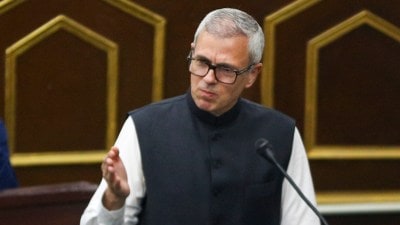‘The poster image is always an appropriation’
Navtej Singh Johar explores the mindscape of Bhagat Singh in Tanashah.
 The still space for self-reflection is evaporating in conventional dance today. Navtej Singh Johar
The still space for self-reflection is evaporating in conventional dance today. Navtej Singh Johar
The last time Navtej Singh Johar made a major work, he was in search of “the amorous song in the body”. It was 2015 and the piece was titled Frenemies. Since then, the Delhi-based dancer has become a chapter in the law books, as a petitioner instrumental in the decriminalisation of homosexuality under Section 377. His first work, after the landmark judgement, looks at a
freedom fighter, Bhagat Singh. In his understanding, Singh is not a militant nationalist but a reflective and intense 23-year-old.
Johar has created a piece based on Singh’s jail diaries and essay, “Why I am an atheist” and infused it with the landscape of Punjab, the poetry of Ghalib and the songs that the martyr loved. “I have titled it Tanashah. This was what his friends used to call him because they thought he was too adamant and bent upon having the last word,” says Johar. Tanashah will have its Delhi premier on March 9. Excerpts from an email interview with Johar:
It has been three years since your last new work. Were you taking a break from dance?
I took a hiatus from performing. Over the years, I have developed a love-hate relationship with dance, so it was time for me to step back to review and redefine dance for myself. The reason I love dance is that it offers me a poetic space for self-reflection, rather self-recognition; and I hate it because of the ways in which dance is being perceived now.
It is becoming slicker and flashier, i.e. of the in-your-face variety, and it is also becoming more conformist and self-congratulatory. The still space for self-reflection is evaporating in conventional dance today. For me, that defeats the very purpose of dance. I had to reconfigure this whole idea of dance and performance for myself, and I was taking my time doing that.
Do you consider Bhagat Singh a poster boy of macho nationalism?
There are people who buy into poster images and then there are people who don’t. The poster image is always an appropriation and a gross reduction of the real to suit a self-serving purpose or agenda. Frankly, I don’t even think that I have ever even registered that image as a ‘nationalist’. Plus, Bhagat Singh’s variety of nationalism is so different from nationalism as we generally perceive it. His position is that of a severe critique. That man, at the age of 23, has searing clarity and he is severely self-critical. He wants to not only rid the country of the British, but he is equally intolerant of the mean and regressive ways of Hindustan. You can see that he is a modernist in that respect, but his brand of nationalism is not to be confused with our popular understanding of nationalism.
How do you see him?
To me he is one of us, a regular young person with a deeply philosophical bent of mind, enquiring, daring, unapologetically unaccepting of any kind of injustice, highly sensitive, and poetic. I am fascinated by his choice, when he was merely 23, to write ‘Why I am an atheist’, virtually as his last word, i.e. he has an eye on posterity plus he is deeply convinced about what he feels and thinks. I find that commendable.
What is the narrative structure you have used to tell his story?
When I started to imagine Bhagat Singh, a passionate young man, locked up within the walls of a prison, where he used to sing Heer, I could not overlook his youthful desire. It brought me to look into masculine desire and his love for poetry and music. An avid reader, in his jail diaries, he cites the poetry of Rabindranath Tagore, William Wordsworth, John Milton, Omar Khayyam, Wajid Ali Shah, Mirza Ghalib and Allama Iqbal. I position myself in this piece and the lines between Bhagat and Navtej remain blurred. I do that because I deeply identify with him and his journey, particularly his transformation from being a believer to becoming a non-believer.
So, I have included Carnatic compositions from my Bharatanatyam repertoire that talk of licence and male desire. I have also delved into the landscape of Punjab, explored my intimacy with the Punjabi language, as well as my love for Carnatic music. In making this piece, I have also stumbled upon how impurity is a binder, it is an equaliser. And how mean and violent the dream for purity is.
Which dance forms and other movements have you used in this piece?
I use somatic movement in this piece to excavate the mindscape of this young man. It is mainly free-form movement with references to Bharatanatyam at some places.
Tanashah will be presented at Stein Auditorium, India Habitat Centre, on March 9, 7 pm.
Tickets on Bookmyshow



- 01
- 02
- 03
- 04
- 05

























